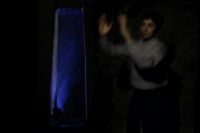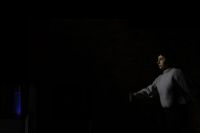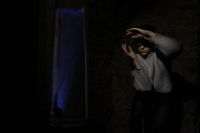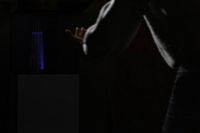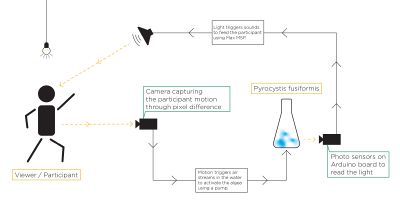Fredblaisb (talk | contribs) |
Fredblaisb (talk | contribs) |
||
| Line 12: | Line 12: | ||
[[File:Performing_Polyphony-01-Web.jpg|200px]] [[File:Performing_Polyphony-04-Web.jpg|200px]] [[File:Performing_Polyphony-02-Web.jpg|200px]] [[File:Performing_Polyphony-03-Web.jpg|200px]] | [[File:Performing_Polyphony-01-Web.jpg|200px]] [[File:Performing_Polyphony-04-Web.jpg|200px]] [[File:Performing_Polyphony-02-Web.jpg|200px]] [[File:Performing_Polyphony-03-Web.jpg|200px]] | ||
======''Documentation photos by Frederic Blais-Belanger''====== | |||
==The technique behind it== | ==The technique behind it== | ||
[[File:Projekt_Schema_final-01.jpg|400px]] | [[File:Projekt_Schema_final-01.jpg|400px]] | ||
Revision as of 16:45, 24 February 2019
Performing Polyphony
A symbiotic performance between human and bioluminescent phytoplankton.
by Frédéric Blais-Bélanger, 2019
_______________________________________________
In music, polyphony refers to the style of simultaneously combining a number of parts, each one being a melody of its own, and at the same time harmonizing with each other. Placed out of its original field, this definition reflects many processes and organisms' behaviour found in nature.
Performing Polyphony explores this idea of collaboration between species as it is a symbiotic duet joining human and Pyrocystis Fusiformis, a form of Dinoflagellates often referred to as Bioluminescent Algea. While the dancer performs, her movements generate air stream into the water, triggering the glow of the algae. Their emission of light is then perceived by a photosensor and translated as sounds that will feed the performer's motion, thus creating a complete loop between the two organisms.
In relation with Haraway's concept, this work is an attempt of "making kin with the earth-bounded". It illustrates on a metaphoric level an interspecies conversation; a symbiotic performance between human and nature.
Documentation photos by Frederic Blais-Belanger
The technique behind it
As a webcam film live the performer's motion, a Max MSP patch compares the image it receives with the previous one, generating a number of the amount of pixel difference. This number controls the air pump, turning it on or off as it reaches a threshold.
A photosensor calculated the amount of light emitted by the algae. This number is then use in Max MSP to trigger notes on a keyboard; the higher the amount of light, the higher the note. The light also affects the tempo of the music as it slows it down when the amount increases and speeds it up when it decreases.
The research and experimentations for the installation was divided in two main parts and were also made within the frame of two other classes. To access the full documentation of these researches, follow the links below:
- The cultivation and understanding of the Pyrocystis Fusiformis
- The elaboration of a communication platform between human and algae
The growth of the project
For this project, I wanted to create a platform where Pyrocystis fusiformis and the viewer would be able to socially interact by the forms of sound and dance. Navigating Donna Haraway idea of making kin with the Earth-bounded, I aimed to bring the viewer to looking at the micro-organism in a different way, and making them both work in symbiosis.
Inspirations and References
Literature
- “Who and whatever we are, we need to make-with—become-with, compose-with—the earth-bound.”, Donna Haraway
- “We must stop seeing tech and nature as sparring partners, and start concentrating on how helping them to dance.”, Molly Flatt, BBC, 2015
- “In the process [of making workable living arrangements], each organism changes everyone’s world. Bacteria made our oxygen atmosphere, and plants help maintain it. Plants live on land because fungi made soil by digesting rocks. As these examples suggest, world-making projects can overlap, allowing room for more than one species.”, Anna Tsing
- “We forget that collaborative survival requires cross-species coordinations.”, Anna Tsing
Artworks
- The Molecular Ordering of Computational Plants, Andreas Greiner and Tyler Friedman, 2018.
- From Strings to Dinosaurs, Andreas Greiner, 2015.
Other
- Polyphony: the style of simultaneously combining a number of parts, each forming an individual melody and harmonizing with each other.
Bibliography
- Haraway, Donna. Staying with the Trouble, Making Kin in the Chthulucene. Durham: Duke University Press, 2016.
- Tsing, Anna. The Mushroom at the End of the World. Oxford: Princeton University Press, 2015.
Final Thoughts on a first Biomedia experience
Coming from a photography based practice, this first experience in Biomedia got me out of my comfort zone.
If I had to describe my experience in one word, I would go for "Failure". It might sounds negative at first, but failure for me is everything but negative. I mean, when is Failure the end of something? Failure is always the beginning of something else; the beginning of a new attempt or a new path in my work. In fact, failure is deeply embedded in the processes of learning. It forces to raise new questions and to look at new angles that then leads to new knowledge and of course progress... a process that actually success cannot bring you.
Even though failures and experimentations have always been part of my art practice, whether it was in the photography darkroom or with video installations, I feel that I have never reached that level of failures since I am in the field of Biomedia.
By working this semester with Pyrocystis Fusiformis, which are Bioluminescent algae, I developed a new creative process; one which “I” have to adapt to medium as I can no longer control it. Through my attempts of creating a platform where the viewer and the living organism could communicate by the forms of movements and sounds, I learned to better care and to better understand my medium as well as other forms of life. It made me look at and acknowledge non-humans, but foremost it made me took a few steps back and pace my productivity down at their own rhythm so we can connect together and work together... or as I like to say, dance together.
So with all the failures Biomedia provided me within the last couple of months, I can definitively say today that I grew up as an artist. I developed new creative processes and new skills but most importantly I’ve opened up myself to new visions of art and nature.
There is actually a better word to express my vision of Bioart: Polyphony. This idea of combining simultaneously two different rhythms, two individual melody, one of the artist and one of the medium, that in the end find a way of harmonizing with each other.
